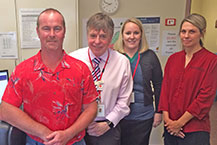Coral Bay nurse Ryan Franks treated his own heart attack last week – and survived.

Heart attack survivor, Coral Bay nurse Ryan Franks, with ETS clinical lead Dr Andrew Jamieson, CNS Dennyel Smith and Dr Bea Scicchitano
About 30 minutes after finishing his shift at the Coral Bay nursing post, the 44 year-old realised he was having a heart attack.
In terrible pain and knowing he could die, Ryan went back to work, hooked himself up to the ECG machine, dialled in to the Emergency Telehealth Service (ETS) based in Perth and called local St John Ambulance volunteers to support him.
Ryan said his years of experience in emergency and remote nursing helped him stay calm and focused as he performed his own ECG, cannulated himself, directed the St John ambulance volunteers on where to find drugs, and then administered the drugs to himself.
Ryan was hoping his chest pain was something minor – but Emergency Telehealth Service (ETS) Emergency Physician Dr Beatrice Scicchitano, who was in Perth interpreting his ECG results, said she immediately knew his situation was serious.
Ryan took pain medicine to help him through the ordeal and remained calm the whole time, knowing that following the right treatment plan was vital.
He had a blood clot in his heart – and he knew it could kill him. He was in terrible pain and could feel himself rapidly getting sicker.
“I was seeing the situation from both the patient and the nurse situation all the time,” he said.
“My 20 years of emergency nursing helped me plan the steps in my treatment.
“I thrombolysed myself – I had to inject the clot-busting drug so the clot could clear and the blood flow could get to my heart,” he said.
The time between walking in the door of the clinic and injecting the drug was vital to his survival – it only took 40 minutes, thanks to the immediacy of the ETS service.
“If I didn’t have the ETS for a rapid diagnosis, my outcome would have been much worse,” Ryan said.
A few hours later, the Royal Flying Doctor Service arrived and transferred Ryan to Sir Charles Gairdner Hospital, where he had a stent and stayed for the weekend.
This week Ryan is back in Coral Bay – and he will be back to work next week.
Last week the ETS announced it has extended its service to be 24/7 – and Ryan was pleased to be involved in the media announcement.
“I have been telling people for years how good the ETS is,” he said.
“I have nursed in Coral Bay on and off since 2003, and I know that working in remote areas is so much safer now for staff and patients because of ETS,” he said.
“Working with ETS doctors and nurses is absolutely great – I have my own Emergency Department in the room when the ETS doctor is on the screen.”